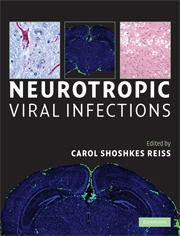Book contents
- Frontmatter
- Contents
- List of contributors
- Foreword
- Preface and acknowledgments
- Section I Introduction: RNA viruses
- 1 Neurotropic picornaviruses
- 2 Subacute sclerosing panencephalitis
- 3 Rabies
- 4 Neurotropic coronavirus infections
- 5 Arenavirus infection in the nervous system: uncovering principles of virus–host interaction and viral pathogenesis
- 6 Neurotropic alphaviruses
- 7 Flaviviruses
- Section II Introduction: retroviruses, DNA viruses, and prions
- Section III Introduction: immunity, diagnosis, vector, and beneficial uses of neurotropic viruses
- Index
- Plate section
- References
2 - Subacute sclerosing panencephalitis
from Section I - Introduction: RNA viruses
Published online by Cambridge University Press: 22 August 2009
- Frontmatter
- Contents
- List of contributors
- Foreword
- Preface and acknowledgments
- Section I Introduction: RNA viruses
- 1 Neurotropic picornaviruses
- 2 Subacute sclerosing panencephalitis
- 3 Rabies
- 4 Neurotropic coronavirus infections
- 5 Arenavirus infection in the nervous system: uncovering principles of virus–host interaction and viral pathogenesis
- 6 Neurotropic alphaviruses
- 7 Flaviviruses
- Section II Introduction: retroviruses, DNA viruses, and prions
- Section III Introduction: immunity, diagnosis, vector, and beneficial uses of neurotropic viruses
- Index
- Plate section
- References
Summary
Introduction
Although vaccinations against the measles virus have nearly eliminated subacute sclerosing panencephalitis (SSPE) and other measles virus-induced neurologic disorders in countries with compulsory immunization programs, SSPE remains a rare, fatal neurodegenerative disorder in many regions of the world. This chapter summarizes current information regarding the epidemiology, virology, clinical manifestations, diagnosis, and management of SSPE.
Epidemiology
Measles
Due to the relatedness (sequence homology) of measles virus with rinderpest virus [1], whose natural hosts are cattle, goats, sheep, antelopes, and other cloven-hoofed animals, some hypothesize that the measles virus originated from the rinderpest virus or a common predecessor. As humans first domesticated such animals in the Fertile Crescent of the Middle East, they would have been in close contact with rinderpest virus [2]. Many morbilliviruses – of which measles and rinderpest viruses are members – can cross species. Recent examples of this phenomenon are the Nipah and Hendra viruses; their natural host is the fruit bat, but both viruses can also infect pigs and humans [3, 4].
Although incursions of the measles virus or a measles-like virus into human populations likely occurred with regularity in ancient times, measles did not emerge as a human disease entity until urban areas of several hundred thousand came into existence about 2500 years ago [5]. Measles virus entered human populations quickly; the virus genome stabilized, and measles virus adapted to replicating efficiently in human cells and transmitting among humans [6]. Measles was appreciated as a disease distinct from smallpox around the tenth century [7].
- Type
- Chapter
- Information
- Neurotropic Viral Infections , pp. 26 - 34Publisher: Cambridge University PressPrint publication year: 2008



